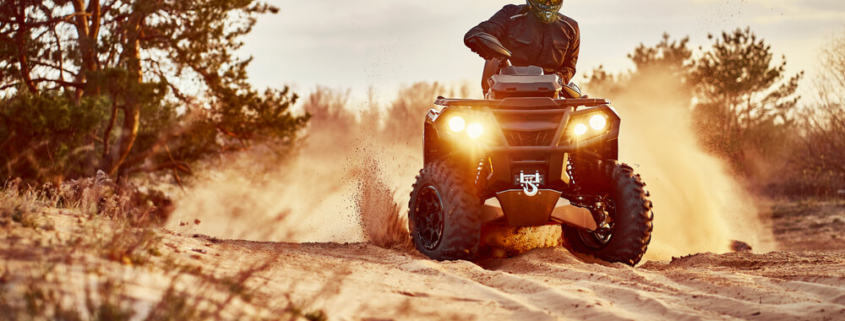Safety Concerns About All-Terrain Vehicles
An ATV (All-Terrain Vehicle) refers to a motorized off-road vehicle meant to travel on four low-pressure tires, with a seat meant to be straddled by the rider and handlebars to control the steering of the vehicle. Type 1 ATVs are to be used by a single operator with no passengers, while Type 2 ATVs are intended to be used by an operator and a passenger.
A “cookie-cutter” or “one-size-fits-all” approach to ATV safety does not work. The ATV industry advises all riders to operate the type and size of ATV meant for their age bracket. Youth model ATVs are designed for smaller feet and hands and travel at a slower speed suitable for younger riders.
ATV Crashes and Death Statistics
According to the United States Consumer Products Safety Commission (CPSC), between the years 1982 and 2016, 15,000 individuals lost their lives in ATV accidents. Over 3,200 of those fatalities were children below the age of 16 years. Sadly, over 1,400 of the children killed in ATV accidents were younger than 12 years.
ATV child fatalities are only a tiny percentage of children who survive injuries on ATVs, many of them devastating. According to CPSC estimates, in 2015, there were 26,700 ATV-related injuries for children below the age of 16. Robert Adler, CPSC Commissioner, has stated, “ATVs remain the most dangerous discretionary use product for children within CPSC’s jurisdiction.”
ATVs are no less perilous for adults. The CPSC estimated that people requiring emergency department treatment for ATV-related injuries was 97,200 in 2015. California, along with four other states, accounts for one-fourth of all ATV-related fatalities in the country.
Inappropriate ATV Size Leads to Many Fatalities, Injuries
ATVs have become increasingly popular in recent years, and this has led to a rise in fatalities and injuries from ATV accidents. Most children killed on ATVs across the country were operating adult-sized ATVs, despite industry advisory.
ATV collisions, rollovers, and ejections can lead to death and severe injuries among children because of their lack of bodily strength and motor coordination required to safely manage an ATV, their limited maturity, and their cognitive and perceptional abilities to react fast and appropriately in hazardous circumstances.
Inherent Design Flaw
ATVs have an inherent design defect that typically contributes to the crashes and injuries they cause. An ATV’s center of gravity is high, making it top-heavy. This means that while they can allow their rider to go easily over uneven, rough surfaces, they can also tip and rollover in the flash of a second.
It does not take much to flip the vehicle over, and a sizable rock hitting an ATV tire at a specific angle is enough to cause an accident. Sadly, such accidents often end in an injury or fatality for the rider. ATVs that are designed for adults are large, ranging anywhere from 250 to 2000 pounds, and can reach speeds up to 60 m.p.h. Thus, it is easy to understand the destruction that these accidents can cause a child rider.
ATV Training, Protective Gear is Vital
It is crucial to choose an appropriately sized ATV, use adequate protective gear, and undergo proper training to protect kids from ATV injuries or fatalities. By undergoing practical ATV rider safety training, you will learn about local regulations, protective gear, places to ride, and environmental concerns pre-ride inspection, starting and halting, hill riding, tight turns, emergency stopping, and maneuvering around obstacles.
Safety Guidelines
Children 16 and below should not operate an adult ATV. A person riding an ATV should follow the below-mentioned suggestions before and during riding:
- Participate in a safety training course to understand how to operate an ATV safely, and only ride an ATV that is appropriate for your size and age.
- Always wear eye protection and an approved helmet.
- Wear long sleeves, long pants, over-the-ankle boots, and gloves to prevent bruises and cuts.
- Only operate the ATV during daylight hours.
- Always ride at safe speeds on a designated ATV trail.
- Learn about basic first aid to address minor injuries and be able to get help in an emergency situation.
While riding an ATV, it is vital to never do the following:
- Never ride while intoxicated on drugs or alcohol.
- Never ride on public roads or paved surfaces (except to cross over them).
- Never exceed the number of manufacturer-recommended passengers.
- Never allow your children or teenagers to ride an ATV with a passenger.
Riding an ATV will always be risky. As they are fun, many children and teens will want to try them. There is no assurance that kids will not get injured, even with precautions and protective regulations in place.
Speak to an Experienced ATV Accident Lawyer in California
ATVs are inherently dangerous, but they also seem to invite risky operator behavior. A majority of ATV crashes occur due to rider negligence, such as ignoring safety regulations, riding when intoxicated, or allowing kids to ride adult ATVs.
ATV accidents also occur due to poor maintenance by the ATV owner or design/manufacturing faults. If you or your loved one has been injured in an ATV collision, or you have lost someone you love because of ATV rider negligence or product defect, you may be entitled to compensation. Unfortunately, many states don’t have robust legislation to protect kids from injury and fatalities in ATV crashes.
The skilled attorneys at Garmo & Garmo are here to help victims and to try to use the legal system to prevent further accidents. For a no-charge consultation with an ATV accident attorney, call today at (619) 441-2500.




